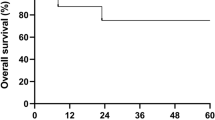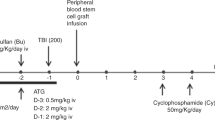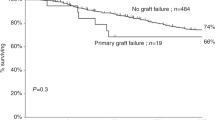Summary:
Graft failure, regimen-related toxicity and graft-versus-host disease (GVHD) are the critical barriers to unrelated donor transplants for aplastic anaemia (AA). We investigated the use of a novel conditioning regimen consisting of alemtuzumab (humanized CD52 antibody), fludarabine and cyclophosphamide in seven patients with AA, who underwent bone marrow transplant procedure using matched unrelated donors. The aetiology of AA was acquired (n=3), Fanconi's (n=3) and congenital (n=1). Median age was 13 years (range 8–35). All the donors were fully matched for HLA class I and II antigens using high-resolution typing. All the patients engrafted at a median of 18 days (range 13–35). Two patients died of transplant-related complications: one of adenovirus disease and the other developed extensive chronic GVHD of skin followed by cytomegalovirus (CMV) disease. Three patients developed Grade II acute GVHD disease (GVHD); none had Grade III–IV acute GVHD. Of the six evaluable patients, only one developed chronic GVHD. We conclude that this conditioning regimen for unrelated donor transplants for AA is sufficiently immunosuppressive to allow stable engraftment and appears to have a favourable impact on the incidence and severity of GVHD, warranting further investigation.
This is a preview of subscription content, access via your institution
Access options
Subscribe to this journal
Receive 12 print issues and online access
$259.00 per year
only $21.58 per issue
Buy this article
- Purchase on Springer Link
- Instant access to full article PDF
Prices may be subject to local taxes which are calculated during checkout
Similar content being viewed by others
References
Guardiola P, Socie G, Pasquini R et al. Allogeneic stem cell transplantation for Fanconi Anaemia. Severe Aplastic Anaemia Working Party of the EBMT and EUFAR. European Group for Blood and Marrow Transplantation. Bone Marrow Transplant 1998; 21 (Suppl. 2): S24–S27.
Bacigalupo A, Oneto R, Bruno B et al. Current results of bone marrow transplantation in patients with acquired severe aplastic anemia. Report of the European Group for Blood and Marrow transplantation. On behalf of the Working Party on Severe Aplastic Anemia of the European Group for Blood and Marrow Transplantation. Acta Haematol 2000; 103: 19–25.
Storb R, Blume KG, O’Donnell MR et al. Cyclophosphamide and antithymocyte globulin to condition patients with aplastic anemia for allogeneic marrow transplantations: the experience in four centers. Biol Blood Marrow Transplant 2001; 7: 39–44.
Hows J, Szydlo R, Anasetti C et al. Unrelated donor marrow transplants for severe acquired aplastic anemia. Bone Marrow Transplant 1992; 10 (Suppl. 1): 102–106.
Deeg HJ, Seidel K, Casper J et al. Marrow transplantation from unrelated donors for patients with severe aplastic anemia who have failed immunosuppressive therapy. Biol Blood Marrow Transplant 1999; 5: 243–252.
Guardiola P, Pasquini R, Dokal I et al. Outcome of 69 allogeneic stem cell transplantations for Fanconi anemia using HLA-matched unrelated donors: a study on behalf of the European Group for Blood and Marrow Transplantation. Blood 2000; 95: 422–429.
Deeg HJ, Anasetti C, Petersdorf E et al. Cyclophosphamide plus ATG conditioning is insufficient for sustained hematopoietic reconstitution in patients with severe aplastic anemia transplanted with marrow from HLA-A, B, DRB matched unrelated donors. Blood 1994; 83: 3417–3418.
Gluckman E, Horowitz MM, Champlin RE et al. Bone marrow transplantation for severe aplastic anemia: influence of conditioning and graft-versus-host disease prophylaxis regimens on outcome. Blood 1992; 79: 269–275.
Wagner JL, Deeg HJ, Seidel K et al. Bone marrow transplantation for severe aplastic anemia from genotypically HLA-nonidentical relatives. An update of the Seattle experience. Transplantation 1996; 61: 54–61.
Kojima S, Matsuyama T, Kato S et al. Outcome of 154 patients with severe aplastic anemia who received transplants from unrelated donors: the Japan Marrow Donor Program. Blood 2002; 100: 799–803.
Champlin RE, Horowitz MM, van Bekkum DW et al. Graft failure following bone marrow transplantation for severe aplastic anemia: risk factors and treatment results. Blood 1989; 73: 606–613.
Deeg HJ, Amylon ID, Harris RE et al. Marrow transplants from unrelated donors for patients with aplastic anemia: minimum effective dose of total body irradiation. Biol Blood Marrow Transplant 2001; 7: 208–215.
Vassiliou GS, Webb DK, Pamphilon D et al. Improved outcome of alternative donor bone marrow transplantation in children with severe aplastic anaemia using a conditioning regimen containing low-dose total body irradiation, cyclophosphamide and Campath. Br J Haematol 2001; 114: 701–705.
Hamblin M, Marsh JC, Lawler M et al. Campath-1G in vivo confers a low incidence of graft-versus-host disease associated with a high incidence of mixed chimaerism after bone marrow transplantation for severe aplastic anaemia using HLA-identical sibling donors. Bone Marrow Transplant 1996; 17: 819–824.
Elebute MO, Ball SE, Gordon-Smith EC et al. Autologous recovery following non-myeloablative unrelated donor bone marrow transplantation for severe aplastic anaemia. Ann Hematol 2002; 81: 378–381.
Glucksberg H, Storb R, Fefer A et al. Clinical manifestations of graft-versus-host disease in human recipients of marrow from HL-A-matched sibling donors. Transplantation 1974; 18: 295–304.
Shulman HM, Sullivan KM, Weiden PL et al. Chronic graft-versus-host syndrome in man. A long-term clinicopathologic study of 20 Seattle patients. Am J Med 1980; 69: 204–217.
Petersdorf EW, Gooley TA, Anasetti C et al. Optimizing outcome after unrelated marrow transplantation by comprehensive matching of HLA class I and II alleles in the donor and recipient. Blood 1998; 92: 3515–3520.
Sasazuki T, Juji T, Morishima Y et al. Effect of matching of class I HLA alleles on clinical outcome after transplantation of hematopoietic stem cells from an unrelated donor. Japan Marrow Donor Program. N Engl J Med 1998; 339: 1177–1185.
Socie G, Henry-Amar M, Cosset JM et al. Increased incidence of solid malignant tumors after bone marrow transplantation for severe aplastic anemia. Blood 1991; 78: 277–279.
Guardiola P, Socie G, Li X et al. Acute graft-versus-host disease in patients with Fanconi anemia or acquired aplastic anemia undergoing bone marrow transplantation from HLA-identical sibling donors: risk factors and influence on outcome. Blood 2004; 103: 73–77.
Cheng YC, Saliba RM, Rondon G et al. Reduced-intensity conditioning (RIC) regimens result in low prevalence of premature ovarian failure (POF) in women underwent hematopoietic stem-cell transplantation (HST). Biol Blood Marrow Transplant 2004; 10: 25–26 (abstr. 51).
Bacigalupo A, Locatelli F, Socie G et al. Fludarabine, cyclophosphamide and ATG for alternative donor transplants in aplastic anemia: a report of the SAA Working Party. Bone Marrow Transplant 2004; 33 (Suppl. 1) (abstr. 189).
Chakrabarti S, Mackinnon S, Chopra R et al. High incidence of cytomegalovirus infection after nonmyeloablative stem cell transplantation: potential role of Campath-1H in delaying immune reconstitution. Blood 2002; 99: 4357–4363.
Avivi I, Chakrabarti S, Milligan DW et al. Incidence and outcome of adenovirus disease in transplant recipients after reduced-intensity conditioning with alemtuzumab. Biol Blood Marrow Transplant 2004; 10: 186–194.
Author information
Authors and Affiliations
Corresponding author
Rights and permissions
About this article
Cite this article
Gupta, V., Ball, S., Sage, D. et al. Marrow transplants from matched unrelated donors for aplastic anaemia using alemtuzumab, fludarabine and cyclophosphamide based conditioning. Bone Marrow Transplant 35, 467–471 (2005). https://doi.org/10.1038/sj.bmt.1704799
Received:
Accepted:
Published:
Issue Date:
DOI: https://doi.org/10.1038/sj.bmt.1704799
Keywords
This article is cited by
-
Hematopoietic stem cell transplantation in FANCJ/BRIP1 fanconi anemia
Bone Marrow Transplantation (2017)
-
Unrelated donor search and unrelated donor transplantation in the adult aplastic anaemia patient aged 18–40 years without an HLA-identical sibling and failing immunosuppression
Bone Marrow Transplantation (2013)
-
Allogeneic stem cell transplantation using alemtuzumab-containing regimens in severe aplastic anemia
International Journal of Hematology (2013)
-
Antibodies in the Treatment of Aplastic Anemia
Archivum Immunologiae et Therapiae Experimentalis (2012)
-
Is it time for a change? The case for early application of unrelated allo-SCT for severe aplastic anemia
Bone Marrow Transplantation (2010)



